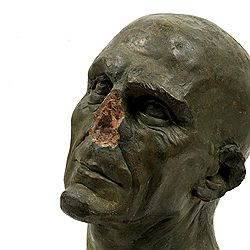The Spread of Terracotta
In Florence, in the early 15th century, the success of terracotta was certainly determined by the demands of an emerging and increasingly richer middle-class who commissioned images of devotion in response to religious solicitations such as the preachings of the Blessed Dominici and of the orders of preachers.

Besides the themes related to the traditional religious pietas was also the spread of small groups for domestic devotion. Among which is the Saint John the Baptist in the Desert from the Bargello Museum ascribed to the Master of the Saint John as a Child. The latter is also the author of other works in terracotta with profane subjects such as the Knight Trampling a Defeated Enemy from the Horne Museum, with Neo-Hellenistic features connected to the late rule of Lorenzo de’ Medici.
During this period portrait as a genre of terracotta production also established itself and, starting from the first Donatellian examples, it would also be imposed in religious iconography as attested by the bust of a Young Deacon by Desiderio da Settignano and the Redeeme by Pietro Torrigiano.